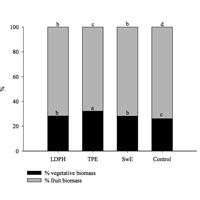Foliar application of plant-based biostimulants improve yield and upgrade qualitative characteristics of processing tomato

Accepted: 20 March 2021
PDF: 1464
All claims expressed in this article are solely those of the authors and do not necessarily represent those of their affiliated organizations, or those of the publisher, the editors and the reviewers. Any product that may be evaluated in this article or claim that may be made by its manufacturer is not guaranteed or endorsed by the publisher.
Tomato (Solanum lycopersicum L.) is a diffused worldwide vegetable. Great amounts of fertilizers are often applied for increasing yield and quality, without considering the negative effect on the environment. A possible perspective for reducing this risk is to raise the nitrogen use efficiency (NUE) through the use of plant biostimulants, which also improve yield and quality concomitantly. The aim of the current study was to verify the potential beneficial effect of three vegetal-based biostimulants on agronomical, qualitative and nitrogen use efficiency of a processing tomato crop. The experiment provided three biostimulants (an extract of brown seaweed [SwE], a legume-derived protein hydrolysate [LDPH] and a tropical plant extract). The following assessments were carried out: marketable and unmarketable yields, mean fruits weight, firmness, pH, total soluble solids (TSS), colour parameters (a/b), hydrophilic antioxidant activity (HAA), lipophilic antioxidant activity (LAA), total ascorbic acid content (AsA), total phenols, nitrate and total nitrogen content, nitrogen use efficiency, N-uptake efficiency, and N-utilization. The foliar application of biostimulants especially protein hydrolysates and seaweed extract significantly affected the marketable yield with an average increase of 18.3% over the control and 41.3% average decrease in unmarketable yield. The N-use and N-uptake efficiency followed a similar trend, with biostimulants boosting it higher than control, +18.4% and +59.3%, respectively; the nitrogen content was also higher in fruits of sprayed plants: +21.3% over control. This finding also reflects on higher dry matter accumulation and firmness in fruits of treated plants (+10.9% and +14.1% over control, respectively). The biostimulants application, in particular SwE and LDPH, also boosted TSS (+12.8%), the a/b colour ratio (+7.5%), HAA and AsA (9.8% and 114.6%, respectively). Therefore, the legume-derived protein hydrolysates and extract of brown seaweed Ecklonia maxima seem a good sustainable approach to improve yield and quality of tomato for canning industries.
Highlights
- The effects of three plant-based biostimulants on yield and quality of processing tomato was explored.
- Application of protein hydrolysates and seaweed extract improve marketable yield.
- The biostimulants had different effect on nutritional and functional quality of tomato.
- Hydrophilic antioxidant activity and ascorbic acid content increased under protein hydrolysate application.
How to Cite

This work is licensed under a Creative Commons Attribution-NonCommercial 4.0 International License.
PAGEPress has chosen to apply the Creative Commons Attribution NonCommercial 4.0 International License (CC BY-NC 4.0) to all manuscripts to be published.

 https://doi.org/10.4081/ija.2021.1825
https://doi.org/10.4081/ija.2021.1825



